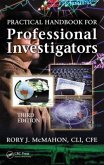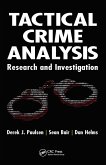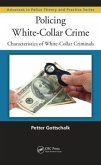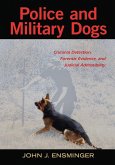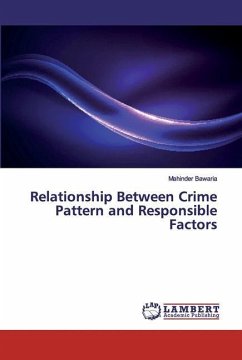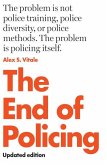Ross M. Gardner, Tom Bevel, Tom J. Griffin
Bloodstain Pattern Analysis with an Introduction to Crime Scene Reconstruction
Ross M. Gardner, Tom Bevel, Tom J. Griffin
Bloodstain Pattern Analysis with an Introduction to Crime Scene Reconstruction
- Gebundenes Buch
- Merkliste
- Auf die Merkliste
- Bewerten Bewerten
- Teilen
- Produkt teilen
- Produkterinnerung
- Produkterinnerung
Blood Stain Pattern Analysis with an Introduction to Crime Scene Reconstruction, Fourth Edition provides criminal investigators and forensic scientists with a complete and comprehensive handbook on bloodstain pattern analysis.
Andere Kunden interessierten sich auch für
![Practical Handbook for Professional Investigators Practical Handbook for Professional Investigators]() Rory J McMahonPractical Handbook for Professional Investigators215,99 €
Rory J McMahonPractical Handbook for Professional Investigators215,99 €![Tactical Crime Analysis Tactical Crime Analysis]() Derek J PaulsenTactical Crime Analysis202,99 €
Derek J PaulsenTactical Crime Analysis202,99 €![Policing White-Collar Crime Policing White-Collar Crime]() Petter GottschalkPolicing White-Collar Crime160,99 €
Petter GottschalkPolicing White-Collar Crime160,99 €![Police and Military Dogs Police and Military Dogs]() John EnsmingerPolice and Military Dogs192,99 €
John EnsmingerPolice and Military Dogs192,99 €![Effective Expert Witnessing Effective Expert Witnessing]() Jack V MatsonEffective Expert Witnessing157,99 €
Jack V MatsonEffective Expert Witnessing157,99 €![Relationship Between Crime Pattern and Responsible Factors Relationship Between Crime Pattern and Responsible Factors]() Mahinder BawariaRelationship Between Crime Pattern and Responsible Factors28,99 €
Mahinder BawariaRelationship Between Crime Pattern and Responsible Factors28,99 €![The End of Policing The End of Policing]() Alex VitaleThe End of Policing10,99 €
Alex VitaleThe End of Policing10,99 €-
-
-
Blood Stain Pattern Analysis with an Introduction to Crime Scene Reconstruction, Fourth Edition provides criminal investigators and forensic scientists with a complete and comprehensive handbook on bloodstain pattern analysis.
Hinweis: Dieser Artikel kann nur an eine deutsche Lieferadresse ausgeliefert werden.
Hinweis: Dieser Artikel kann nur an eine deutsche Lieferadresse ausgeliefert werden.
Produktdetails
- Produktdetails
- Verlag: Taylor & Francis Ltd
- 4. Auflage
- Seitenzahl: 512
- Erscheinungstermin: 26. Februar 2025
- Englisch
- Abmessung: 254mm x 178mm
- ISBN-13: 9781032528502
- ISBN-10: 1032528508
- Artikelnr.: 71550540
- Herstellerkennzeichnung
- Libri GmbH
- Europaallee 1
- 36244 Bad Hersfeld
- gpsr@libri.de
- Verlag: Taylor & Francis Ltd
- 4. Auflage
- Seitenzahl: 512
- Erscheinungstermin: 26. Februar 2025
- Englisch
- Abmessung: 254mm x 178mm
- ISBN-13: 9781032528502
- ISBN-10: 1032528508
- Artikelnr.: 71550540
- Herstellerkennzeichnung
- Libri GmbH
- Europaallee 1
- 36244 Bad Hersfeld
- gpsr@libri.de
Tom Bevel is the President and creator of Bevel, Gardner and Associates Inc., a forensic education and consulting company. He was an associate professor in the Masters of Forensic Science program at the University of Central Oklahoma, Edmond, Oklahoma. He retired after 27 years with the Oklahoma City Police Department. His last assignment was the Commander of the Homicide, Robbery, Missing Persons, and the Major Unsolved Case units. Ross M. Gardner is Vice President of Bevel, Gardner and Associates. He worked for the U.S. Army Criminal Investigation Command (USACIDC) as a felony criminal investigator for nearly 20 years. He retired as a Command Sergeant Major and Special Agent in 1999 after serving a total of 24 years in the U.S. Army law enforcement. Mr. Gardner subsequently served four years as the Chief of Police for Lake City, Georgia, a small suburban Atlanta police department. He is now retired and active in independent consulting. Tom J. "Grif" Griffin is the owner of Griffin Forensic Solutions & Consulting, LLC, and a partner in Bevel, Gardner & Associates. Mr. Griffin holds a bachelor's degree in chemistry from The Colorado College and did graduate work in chemistry at the University of Northern Colorado where he designed and instructed a course in forensic chemistry. He worked as a criminalist and CSI at the Greeley, Colorado Police Department for four years before going to the Denver office of the Colorado Bureau of Investigation as a forensic chemist, crime scene investigator, and bloodstain pattern analyst. He retired from CBI after 27 years to become a private consultant and instructor.
1. History of Bloodstain Pattern Analysis. 2. Bloodstain Pattern Analysis's
Place as a Scientific Discipline 3. Bloodstain Pattern Terminology 4. The
Pattern Diversity Principle: Classifying Bloodstains 5. Stain Shape and
Vector Correlation-Issues of Motion and Spatial Origin 6. Stain Shape and
Vector Correlation-Area of Origin Considerations 7. Evaluating Impact
Spatter 8. The Physically Altered Bloodstain 9. Bloodstain Fabric
Considerations 10. A Methodology for Bloodstain Pattern Analysis 11.
Presumptive Testing and Enhancement of Blood 12. Documenting Bloodstain
Patterns 13. Experimentation in Bloodstain Pattern Analysis 14.
Introduction to Crime Scene Analysis 15. Presenting Evidence App A.
Weight/Measurement Conversion Table App B. Trigonometric Functions and
Their Application in Bloodstain Pattern Analysis App C. Dealing with
Blood-Borne Pathogens App D. Detailed Explanation for Using the BPA
Decision Map, With Examples
Place as a Scientific Discipline 3. Bloodstain Pattern Terminology 4. The
Pattern Diversity Principle: Classifying Bloodstains 5. Stain Shape and
Vector Correlation-Issues of Motion and Spatial Origin 6. Stain Shape and
Vector Correlation-Area of Origin Considerations 7. Evaluating Impact
Spatter 8. The Physically Altered Bloodstain 9. Bloodstain Fabric
Considerations 10. A Methodology for Bloodstain Pattern Analysis 11.
Presumptive Testing and Enhancement of Blood 12. Documenting Bloodstain
Patterns 13. Experimentation in Bloodstain Pattern Analysis 14.
Introduction to Crime Scene Analysis 15. Presenting Evidence App A.
Weight/Measurement Conversion Table App B. Trigonometric Functions and
Their Application in Bloodstain Pattern Analysis App C. Dealing with
Blood-Borne Pathogens App D. Detailed Explanation for Using the BPA
Decision Map, With Examples
1. History of Bloodstain Pattern Analysis. 2. Bloodstain Pattern Analysis's
Place as a Scientific Discipline 3. Bloodstain Pattern Terminology 4. The
Pattern Diversity Principle: Classifying Bloodstains 5. Stain Shape and
Vector Correlation-Issues of Motion and Spatial Origin 6. Stain Shape and
Vector Correlation-Area of Origin Considerations 7. Evaluating Impact
Spatter 8. The Physically Altered Bloodstain 9. Bloodstain Fabric
Considerations 10. A Methodology for Bloodstain Pattern Analysis 11.
Presumptive Testing and Enhancement of Blood 12. Documenting Bloodstain
Patterns 13. Experimentation in Bloodstain Pattern Analysis 14.
Introduction to Crime Scene Analysis 15. Presenting Evidence App A.
Weight/Measurement Conversion Table App B. Trigonometric Functions and
Their Application in Bloodstain Pattern Analysis App C. Dealing with
Blood-Borne Pathogens App D. Detailed Explanation for Using the BPA
Decision Map, With Examples
Place as a Scientific Discipline 3. Bloodstain Pattern Terminology 4. The
Pattern Diversity Principle: Classifying Bloodstains 5. Stain Shape and
Vector Correlation-Issues of Motion and Spatial Origin 6. Stain Shape and
Vector Correlation-Area of Origin Considerations 7. Evaluating Impact
Spatter 8. The Physically Altered Bloodstain 9. Bloodstain Fabric
Considerations 10. A Methodology for Bloodstain Pattern Analysis 11.
Presumptive Testing and Enhancement of Blood 12. Documenting Bloodstain
Patterns 13. Experimentation in Bloodstain Pattern Analysis 14.
Introduction to Crime Scene Analysis 15. Presenting Evidence App A.
Weight/Measurement Conversion Table App B. Trigonometric Functions and
Their Application in Bloodstain Pattern Analysis App C. Dealing with
Blood-Borne Pathogens App D. Detailed Explanation for Using the BPA
Decision Map, With Examples


